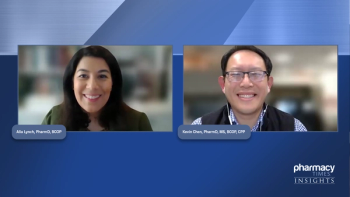
Monitoring for Treatment Toxicities Associated with Care for MM
Navigating treatment toxicities is paramount to achieving treatment goals in MM management.
Ryan Haumschild, PharmD, MS, MBA: When we think about some treatments, as well, we think about the toxicities that are involved. Not just teaching the patient about the toxicities—which you did a great job of giving us an overview—but even as health care practitioners, how are we monitoring these patients? If we saw a certain toxicity arise a month in during the clinical trial, how do we make sure in the real world we’re also monitoring during that period? As a pharmacist practicing within the clinical setting, how are you monitoring patients for the different treatment toxicities: Are you doing it within the EMR [electronic medical records], within the order set, [or] do you have a case management program in the background? Specifically…how are you managing and overseeing the toxicities related to proteasome inhibitors so you can also intervene early for your patient to keep them on therapy longer but…reduce the chance of toxicity?
Gabe Hinojosa, PharmD, BCOP: Sure. Technology is our friend when it comes to monitoring patients for toxicity. That is happening primarily through the EHR [electronic health records], so we can build specific monitoring parameters to our treatment plans at designated time points, and that could serve as a lab order that could be monitoring [ECGs] or echocardiograms at specific time points for patients on proteasome inhibitors that may have cardiac toxicities. We can build in specific communication orders to providers and nursing at certain time intervals that are instructing them to conduct an oral assessment and review the patient for any signs of neuropathy or other toxicities and to alert providers if we have grade 1, grade 2, grade 3 neuropathy or other toxicities at any time frame. Building those things into the order sets as much as we can, either through active orders or as communication orders, really plays a large role. We also see things as simple as an electronic calendar really become our friend from the pharmacy perspective. If we know that something needs to be done within a certain time frame or we know that certain toxicities are most common to arise within a certain time frame, [then] when we’re reviewing a plan and profiling it for patients starting therapy, I can easily go into my Outlook calendar, iCalendar, or whatever calendar I’m using and set a reminder to myself: On day 28 from this therapy, check in on patient X and see what’s going on and read through their most recent visit note with the provider, and look for some of these notes.
Ryan Haumschild, PharmD, MS, MBA: Thanks for giving us that overview. There are a lot of tips and tricks that we can all learn from really to benefit our patients. I want to pivot to Dr Anderson. You’ve been at the forefront of multiple myeloma [MM] therapy for a long time, and you’ve practically built the program at your institution. As we think about the treatment of MM, there are a lot of exciting things that have happened so far, but what are the promising developments in your eyes within the relapsed refractory [RR] space, and…if you could characterize those, whether it’s screening therapy or overall treatment, what is most promising to you?
Larry Anderson, MD, PhD, FACP: I would say the biggest change and the most promising thing is T-cell redirection therapy, whether that be cellular infusions with CAR [chimeric antigen receptor] T cell or bispecific antibodies used to redirect T cells. It’s just revolutionizing the outcomes that we’re seeing in these heavily RR patients. I think the most promising thing currently in myeloma is moving those earlier in the lines of therapy and trying to see if we can get even better, longer-term remissions from these patients if we move them [from] second line [to] frontline. So, I’m excited to seek trials coming up looking at comparing these immunotherapies or T-cell therapies, frontline compared to standard of care. So that’s going to be exciting to see if we can move the needle on the outcomes that we’re seeing in myeloma.
Ryan Haumschild, PharmD, MS, MBA: The combination therapy I think is something we’ve seen in MM for a while, but you’re right, seeing BCMA [B-cell maturation antigen]–targeted agents combined with others earlier, giving deeper responses, I think is exciting. I’d love to hear your thoughts too on MRD [minimal residual disease] and the role that it plays because I know within health plans, [if] the patient does have MRD, there [have] been some data to show that patient could even go off maintenance therapy and [be] adverse effect free for a number of years. So, what do you think about the role of MRD in MM, maybe now, but more so in the future?
Gabe Hinojosa, PharmD, BCOP: A lot of the current trials are really incorporating MRD to try to see if we can have a defined duration of induction, consolidation, or maintenance. We are routinely using molecular testing for MRD. We don’t necessarily have all the answers yet on how to use that. We’re still trying to gather that, but let’s say you have a patient who had sustained MRD negativity for a couple of years and they’re not really tolerating their maintenance therapy very well; that’s a patient [about whom] you can say, I think we can safely stop their therapy, or if they’re having some mild adverse effects but their MRD levels are rising, you’re probably not going to want to stop their therapy, and you’re going to watch them even more closely to watch for true progression in those patients as well.
Transcript edited for clarity.
Newsletter
Stay informed on drug updates, treatment guidelines, and pharmacy practice trends—subscribe to Pharmacy Times for weekly clinical insights.



